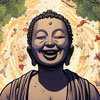Spiritual Growth Through Meeting Self
 by Kevin Todeschi
by Kevin Todeschi
For constantly is the soul-entity meeting self in its activities, in its relationships. And what it does about creative influences in its experience makes for that which either becomes a developing or a retarding. Cayce Reading 1604-1
What if everything you ever did somehow came back to you? What if this boomerang action were designed to enable you to face how every element of your life had affected someone else? What if you were truly held accountable for all of your actions, for all of your words, even for all of your thoughts? What if this accountability were not some kind of universal judge and jury, but rather, a portion of your own soul that kept track of everything within your being that was out of alignment with spiritual wholeness, so that it could become transformed? What if this transformational process were inevitable for every soul? What if this process of meeting yourself truly had your best interests at heart?
In the Cayce cosmology, too often we are shortsighted in attempting to discover the basis for our life’s challenges and problems. A thirty-seven year old bookkeeper who was in the midst of marital difficulties was advised: “For each soul, each entity, constantly meets self. And if each soul would but understand, those hardships which are accredited much to others are caused most by self. Know that in those you are meeting thyself!” (845-4) On another occasion a thirty-one year old woman who had a serious problem with facial neuralgia inquired, “Please give the origin of all of this trouble.” The reading replied, “It began about thirty-five thousand years ago! This is the trouble!” (3517-2) It then proceeded to encourage her to follow through on the therapeutic suggestions that had been outlined for her treatment.
The sense that every life experience can be seen as a learning process if only an individual will choose to do so is clearly illustrated in the case of Lorraine, a forty-eight year old woman who requested a life reading. Twelve years earlier, she had been stricken with polio encephalitis and was unable to walk from that time on. The debilitating nature of her condition had taken its toll on her and her family, and a number of different treatments had been sought. Finally, Lorraine came to Edgar Cayce for help. She was convinced that there was something standing in the way of her own treatment because doctors had been unable to assist her. In her letter, she wrote, “I feel increasingly that there must be some mental and spiritual block that must be removed before much physical progress can be made . . .”
During the course of her reading, Cayce counseled the woman to begin seeing her condition as a purposeful experience, one that would enable her to overcome a soul frailty that had occurred when she had lived in the Roman Empire. He reminded her gently, “For as one soweth, so one reaps; else the very Divine would be mocked among the children of men.” (1504-1) The reading informed Lorraine that she had been a member of the emperor’s court and had very much enjoyed the games of “sport” in which the Christians had been thrown to the lions. She was told, “And the entity laughed at those who were crippled by such activities; and lo, they return again to thee!” She was now having the opportunity to meet within herself some of the same pain and suffering that she had once made light of in others.
To make the situation even more interesting, the reading advised her that some of the family members who were now taking care of her had once been the same individuals she had watched suffer and die in the arena. It suggested that she attempt to see the situation in a completely new light: “How blest then art thou, that there are those close to thee that ye once laughed at; that are patient, that are kind, that are gentle with thee!” The biggest obstacle to Lorraine’s healing was herself. The challenge seemed to be one in which she was supposed to learn to become loving, patient, and kind with those who attempted to help her—in spite of her challenges and pain. She had taken her family for granted, and Cayce suggested that she could “give much, much the more to those about her . . .”
As physical treatments, the readings recommended frequent electrical stimulation to the muscles and a variety of therapeutic massages. Cayce suggested that if she followed the treatment, began meditating, changed her attitude, and attempted to cultivate the same degree of loving service that was being shown to her by others, the very cells of her body could become rejuvenated.
After receiving the reading, Lorraine wrote, “This is to thank you from the bottom of our hearts for the reading. You don’t know what it is doing for us. This happens to be a very troubled moment, and that crystal-pure well of thought is holding us together.” Three weeks later, Lorraine wrote again and stated that she had already felt the effects of treatment and was hoping for a quick recovery. She was convinced that her physical trouble was only temporary and would be healed very rapidly. Cayce wrote back and asked her to ponder the following:
“. . . the existent conditions are the effect of long-submerged hindrances that at last found expression in a way that requires you to depend upon others, the thing mentally that you hated, and as the Psalmist said, ‘That which I hated has come upon me.’ As it has been a growth, and the mind is the builder, so to come out of it also must be a growth. Would a momentary healing bring the lesson that is to be learned?”
Cayce encouraged Lorraine to keep him posted on her progress and to find ways in which she could be “good for something,” especially in the lives of those who were tending to her needs.
Three months later, Lorraine wrote to say that she was still very happy with the mental and spiritual advice that had been provided in her reading, but that she was somewhat disappointed in the physical information because, “I feel increasingly convinced that if there is to be any recovery, the cure will be instantaneous and bordering on the miraculous.” Although a number of letters were exchanged between Lorraine and Edgar Cayce in 1938, by year’s end he received no further communication from her.
It appears that Lorraine was unable or unwilling to follow the advice that Cayce had given her. In 1974, Lorraine’s daughter got in touch with Cayce’s Association a year after her mother’s death and requested a copy of her mother’s reading. It was sent, along with a letter of inquiry asking for an update on what had happened to Lorraine since the course of her reading. The daughter’s letter stated, in part:
“You ask[ed] me to make any comments relevant to the Cayce reading on my mother. She suffered from poliomyelitis and many painful and frustrating conditions during her life. Edgar Cayce, according to the reading, was of the opinion that she could have been healed. To the best of my knowledge, she did not follow through with his advice and told me later that he had given her nothing more helpful than that she was paying off a karmic debt. She lived, in spite of cancer, arthritis, diverticulitis, chronic bladder inflammation, etc., etc., to the age of eighty-three, dying quite senile. It is most regrettable to her family that she did not make the total effort at self-healing which was available to her . . .”
On another occasion, a thirty-nine year old, unmarried hairdresser obtained a life reading and was told that her challenges with relationships were apparently due to a series of past lives that was still affecting the present. Cayce told her that she often seemed to seek out “disturbing” relationships in the present because she was lonely, very unwise in love, and apparently meeting a situation from an earlier incarnation.
Previously, she had been a Grecian maiden who was an entertainer and possessed great beauty. In an attempt to better her position, she had often ensnared the hearts of men who might help her gain position, place, or power. She was now meeting that experience in the present. Cayce suggested that she needed to change her approach to people as well as her perception of herself. She was encouraged to discover the talents and abilities within herself rather than looking at people in terms of what they might be able to do for her. She also was encouraged to begin interacting with others differently. Cayce said that his advice in this regard was applicable to everyone: “Would that each soul would make that as a rule, a determining factor, ‘In each contact, each conversation with another, I will leave a thought, an idea, that will better that individual.’” (2438-1) The reading told her that if she followed this advice, she would inevitably find the love in relationships that she was seeking.
A contemporary example of relationship difficulties is seen in the story of Ken Archer. Ken is a forty-eight year old supervisor at a water treatment facility. After having been through three very emotional relationship breakups, he is convinced that one of this greatest life lessons has been to learn how to love unconditionally. He admits that it is a lesson with which he is still struggling. For much of his life, he had the mistaken assumption that happiness could be found in relationships by getting the other person to “think like me.” He has come to realize that true love is the ability to perceive other individuals as they are, “with no desire on your part to change them.” Even after having come to this realization, however, Ken admits that he has yet to find true intimacy in a one-to-one relationship with a woman, prompting him to say, “There is more to learn.”
An example from the Cayce files of an individual positively meeting the consequences of previous actions is the life of Frances Davidson, who was seventeen years old when she obtained a physical reading to help her with a serious weight problem. The reading stated that the problem was a glandular condition and could be corrected with outdoor activity, exercise, and a change in diet that eliminated starches. Additional recommendations included spinal manipulations and the consumption of grape juice throughout the day, mixed half-and-half with water. The treatment was followed, and five months later, her mother reported that Frances had lost a lot of weight and was almost down to her ideal dress size. Because the health reading had proven so helpful, the family requested a life reading for the girl. During the course of her second reading, Cayce traced the glandular imbalance that was causing her predisposition to weight gain to a lifetime in Rome:
“There we find the entity excelled in beauty, in the ability to carry in figure, in body, the games that were a part of the experience. And too oft did the entity laugh at those less nimble of activity, owing to their heaviness in body. Hence we find the entity not only meeting same in the present from a physical angle but there are the necessities of it being worked out by diet as well as outdoor activity.” 1339-2
She was encouraged to continue being active in outdoor sports, especially golf, archery, boating, riding, and tennis. By doing so, Frances could meet those same emotions within herself that had led to the weight problem in the present.
Cayce often discussed the idea that our challenges and difficult experiences in life are not so much because of others, but as a means of an individual addressing something within self. A twenty-seven year old woman, still living at home and having problems with both her parents and her brother, wanted to know what kind of karmic debt she was working out with these three people. Cayce advised her that there really isn’t such a thing as a karmic debt between people, but rather there is a memory within oneself that has the possibility of being worked out by being with certain individuals. The woman’s current situation was an opportunity to transform herself by working on these relationships with her family members (1436-3).
Another physical case history of an individual meeting self is the story of Carl Thompson, a twenty-one year old student studying to become a physician. His only physical problem seemed to be a tendency toward anemia. He was told that his life could lead to erratic love affairs, to violence, or to the opportunity to make a great deal of money. More than anything else, Carl’s free will would play a major role in deciding the course and direction of his life.
The reading told Carl that the anemia would present itself throughout much of his life unless he took measures to address what had caused the problem in the first place. Apparently he had been a warrior in Peru who took part in overthrowing the country’s government and leader; in the process “much blood was shed.” (4248-1) The result of this meeting himself in the present was anemia.
Carl’s additional past lives included a sojourn at the time of the Crusades, when he had attended to both the physical and mental problems of people who had been injured. For this service to others, he had gained and continued to possess talents in both anatomy and psychiatry. As an armor bearer in Egypt, he had led a rebellion against the king but had later reconciled with the ruler, and eventually he gained in that lifetime, being able to learn and grow because of the various experiences he had been through. In the present, Carl was encouraged to pursue work as a teacher or as a physician and counseled to give expression to his own development, focusing on a balanced approach that would assist him physically, mentally, and spiritually.
Excerpt from Edgar Cayce On Mastering Your Spiritual Growth
See Part II here.
Posted in Other Topics, Reincarnation, Spiritualitywith comments disabled.





